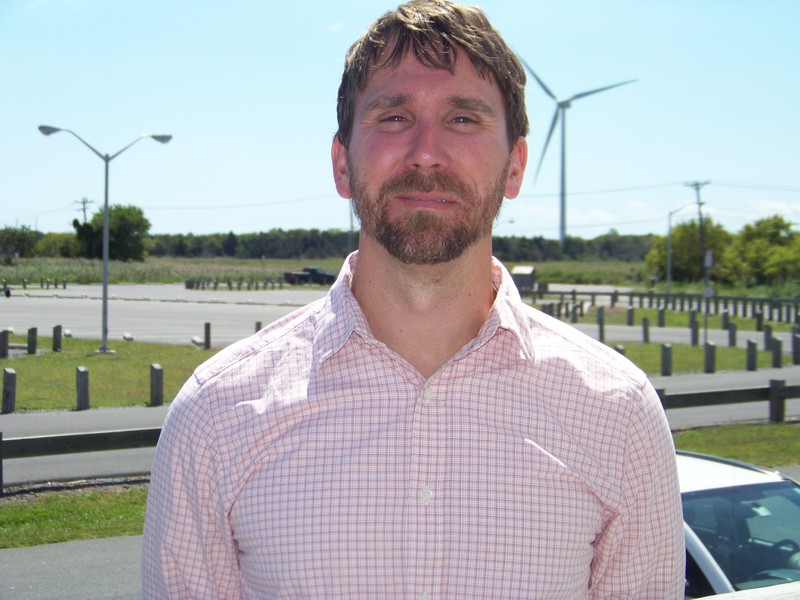Bart Wilson: In the line of fire
Most people prefer to run away from fires. Bart Wilson took his vacation to be near them.
Wilson recently spent two weeks in Utah and Idaho as part of a 20-man team putting out wildfires as his vacation from Center for the Inland Bays, where he serves as the center's science and technical coordinator. His urge to fight fires stemmed in part from his love of the great outdoors.
“At a young age, my parents were always the type of people who were like, ‘Go outside and play. Don’t just sit in front of the TV, go out and play.’ Then I was in the Boy Scouts as well, my whole childhood. So that really inbred being outside,” he said.
Wilson had never been a firefighter before, but was interested in it and was persuaded by a friend to train to put out wildfires.
After training in March, Wilson waited for the call to go out. He thought he was headed with a crew to Alaska, but that opportunity fell through. Wilson said he waited for his crew leader, Sam Topper, to call for another opportunity.
“That was one of the worst parts, the anticipation,” he said. “I was almost resigning myself, “Oh, I guess we’re not going to go.’”
Eventually, Wilson got the call to go. Crews are trained and dispatched through Delaware Forest Service, a state division of the Department of Agriculture. Most of the crew Wilson was on were state employees and civilians, he said.
Crews are only out for 18 days - 14 on the line and four for travel - but the work is hard: nonstop 16-hour days. Wilson’s crew spent eight days in Utah helping battle the Patch Springs Fire in the Stansbury Mountains, an area about two-and-a-half hours from Salt Lake City. The fire was started by a lightning strike.
“It was a very barren place. Very dry,” Wilson said. “We got there around noon and immediately we were out there hiking, securing the fire lines. It’s kind of a desolate area. It’s rangeland. But there’s a couple of small towns, and one of things that happened is this fire started moving toward these small towns.”
The crew would wake up at 5 a.m., pack up its gear, eat breakfast, get briefed and then head out into the fire, Wilson said. Usually the crew wouldn’t eat dinner until 10 p.m. and slept in tents. Work was very busy, Wilson said, and often chaotic: besides firefighters on the ground clearing the area, planes would fly overhead dumping water and retardant.
“It’s exciting, scary and exhilarating,” he said. “It was just surreal all the activity.”
Once the Patch Springs Fire was mostly contained, the crew was reallocated to help battle the Howard Fire in Payette National Forest, about two hours north of Boise, Idaho. Wilson said the crew drove nine hours to get to their campsite.
“The Howard Fire was about 200 acres, but it was very steep-sloped mountains,” he said. “This area we were trying to prevent the fire from spreading, but then also it’s endangered bull trout habitat in the Snake River along there. So they were trying to minimize the amount of ash that got into the river.”
Because of the steep incline of the mountain, the crew could not see one another up ahead. One day, Wilson said, he had to avoid a log that had gotten loose and rolled down the mountain into the valley where he was working. Physically, Wilson said he was fine: he works out at Crossfit Dover. The most difficult part of firefighting, he said, was the mental aspect, fighting the daily grind of the job. All told, Wilson was gone from Aug. 11 to Aug. 28
Originally from Pennsylvania, Wilson is a graduate of University of Delaware who has worked for the center for a year-and-a-half. He spent the previous nine years at the Department of Natural Resources and Environmental Control.
Despite living in Dover, Wilson said he enjoys coming to the beach along with his wife, Kerry, and daughters Shay, 9, and Sadie, 4. He said before he had kids, the Wilsons liked to go hiking together: Wilson proposed to his wife while on a hiking trip near Calgary, Alberta, Canada. Wilson said he has tried to instill a love of camping in his kids, taking trips to Chincoteague, Va.
The firefighting excursion wasn’t always easy for the family, Wilson said, especially when the crew moved to Idaho where there was no cell phone service.
Wilson admitted it was a bit of an adjustment coming back. He was forced to jump right back into work at the Center for the Inland Bays, preparing a presentation for a Sept. 6 scientific and technical advisory committee meeting.
Still, Wilson said he plans to go into the line of fire again.
“For me, it really put things into perspective in my life,” he said of the excursion. “I think it’s one of those things that you’re doing for a good reason. You can learn a lot about yourself doing it.”
Editor's note: An earlier version of this story incorrectly identified the agency that trains and dispatches firefighters.
Ryan Mavity covers Milton and the court system. He is married to Rachel Swick Mavity and has two kids, Alex and Jane. Ryan started with the Cape Gazette all the way back in February 2007, previously covering the City of Rehoboth Beach. A native of Easton, Md. and graduate of Towson University, Ryan enjoys watching the Baltimore Ravens, Washington Capitals and Baltimore Orioles in his spare time.
























































